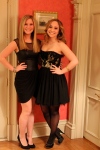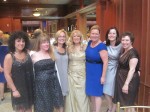That looks nothing like my house. I don’t think that looks anything like anyone’s house. It looks a little structurally unsound to me and there is an entire lack of curb appeal, probably due to the lack of curb. You can’t blame the artists though, no one tells first graders to be more realistic during art class. Here is my actual house:
That is the only picture I can find of my house. I have never taken a picture of it, and until now I have never felt that I was lacking. I see this picture and I know it is my house: It was my address in google maps, the house, the driveway, the detached garage, and the backyard patio are all mine, too. I recognize these things as being parts of my house but I’ve never looked at them like this. This way, this birds-eye, property view is not the place I recognize. This picture looks like my house, but this picture does not look like my home. My memory of home has nothing to do with the property lines or floor plans. To me my home looks like this:
Come to think of it my home looks like this too:
You caught me. There isn’t a beach in Morristown and that picture wasn’t taken there. Actually, none of the places in the second crop of pictures are actually at the house depicted in the google map – but they are all still home to me, although they don’t take place at my actual home.
When others look at the pictures the only constants are the familiar faces that carry over from photograph to photograph. While you can see these faces, and hairstyles and heights change over time, the pictures all have the same basic formula: it’s me and some of the people who are important to me beaming (and sometimes blinking) at a camera. They are obligatory pictures, but we are all happy to oblige. The truth is I have been taking these same photographs for years and years. Every part of the year has a specific place for me- and that is my home for that time and event.
Over the summer we take the picture of all my cousins on the beach. Later, just my sister and I go back to the beach to take pictures for our holiday card. Before the first day of school or before going to temple on the high holy days my sister and I take pictures by the bush in front of my garage. On the first night of Hanukah we take a picture of my sister standing in front of me while lighting the menorah in the dining room. At Christmas we take a group picture of everyone in our living room with my grandpa in the middle. On St. Patrick’s day we are at my Aunt Patty’s house in Florida and take a picture by their pool of everyone wearing their resounding green. At Easter we take a picture of the cousin on my Aunt Gina’s front steps right before the egg hunt. By spring the bush in front of my garage has leaves again and I can take more pictures in front of it – just in time for prom. The cycle repeats itself over and over.
My life is a series of repeated photographs. Most people’s are. Who doesn’t have first day of school photos? Holiday photos? Vacation photos? Birthday photos? This process repeats and all of the sudden you feel like that guy who took a picture of himself every day for 8 years (http://jk-keller.com/daily-photo/). You may do this with more time in between your pictures but you do it for about 18 years. I did, at least.
Then it was time for this picture:
And by August I was off to a new place that I only new as this:
or this:
I recognized Vanderbilt, like I recognized an aerial picture of my Morristown house – I knew it was where I would live, but it did not look like my home. I couldn’t even imagine being inside, the way I can imagine my own house. I didn’t know what the inside of the building would look like and more importantly I didn’t know how I would look on the inside of the buildings.
The first thing that started to make me feel at home was actually a photograph. Before I got to my future room, my future roommate put this picture on facebook:
She tagged me in that picture and thus the picture of the door technically became the first picture of me at Vanderbilt. One little picture kicked off four-years of living and taking pictures in my new home. It clicked that here is where I’d be instead of in NJ.
Because I go to school so far away from New Jersey I cannot be in all of the pictures that I used to – there is no first day of school picture of me in my driveway, or pre-egg hunt in my pajamas, and a few others I am missing from as well – but that hasn’t stopped me from taking new pictures of my new experiences with new friends. Every one of the iconic photographs that I perpetually take with my family started with a single picture. Then we decided we liked it, all of it – the day, the moment, the people, and the picture – so we decided to do it again. Over time, these moments and these people are no longer just a snapshot in time, but the repeated experience makes it our home. Home is the place where the things happen that you want to repeat.
Some people get caught up thinking that home is simply where you start from, but home is really the places you establish as you go throughout your life. There’s no limit on the places that you can make your home, it is only a matter of finding places and people that you keep wanting to come back to.
On the pin board in my kitchen there is a picture of my mother and her friends on their graduation day from nursing school, and here they are at Judy’s son’s wedding many years later.
They have a reunion every year, wedding or not, and have always found a way to come back to one another. Now that I have embarked on my own college experience they are my inspiration for finding people who I want to surround myself with, who I want to see year after year. I look forward to turning new places and people into my home away from home. There is no limit on the place that you can call home, but it is not a matter of just finding them, it is a matter of keeping them and making them a part of your tradition. Live. Smile. Photograph. And repeat.
a bit homier now




























 These two pictures are both of the same place, they were taken moments apart, and yet they look entirely different. The only difference is the change that a camera can make.
These two pictures are both of the same place, they were taken moments apart, and yet they look entirely different. The only difference is the change that a camera can make.

